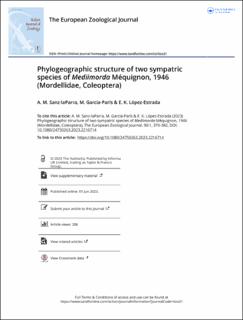| dc.contributor.author | Sanz-laParra, Annui Malla | |
| dc.contributor.author | García-París, Mario | |
| dc.contributor.author | López-Estrada, Estefany Karen | |
| dc.date.accessioned | 2024-03-06T12:17:54Z | |
| dc.date.available | 2024-03-06T12:17:54Z | |
| dc.date.created | 2023-10-24T14:43:48Z | |
| dc.date.issued | 2023 | |
| dc.identifier.issn | 2475-0263 | |
| dc.identifier.uri | https://hdl.handle.net/11250/3121283 | |
| dc.description.abstract | Sympatric distribution and syntopy are not common in closely related species since sporadic crosses may lead to the formation of hybrid zones disrupting the differentiation of sympatric incipient species. In Central Spain two morphologically similar species of Mediimorda Méquignon, 1946, M. batteni Plaza-Infante, 1985 and M. bipunctata (Germar, 1827) are strictly sympatric. Mediimorda batteni is endemic to the Iberian Peninsula while M. bipunctata is widely distributed in the Western Palaearctic Region. Intriguingly, sympatric distribution among closely related taxa that exhibits little morphological variation is not common. This makes us wonder if we are really facing two independent evolutionary units of Mediimorda as previously proposed or just two phenotypic morphs of a single taxon. To test for this hypothesis, we performed Bayesian and phylogeographic analyses based on mitochondrial (cox1) and nuclear (ITS2) data and estimated divergence time of clades. Additionally, a morphological revision and construction of potential distribution models were included to determine possible niche differences. Our results corroborate the existence of two lineages well differentiated, that probably diverged during the Pliocene. According to the morphology, each clade corresponds to the previously recognized M. batteni and M. bipunctata. The absence of hybridization and ecological segregation suggests that sympatric and syntopic distribution was accomplished long time after the speciation event that separated the two taxa took place. We propose that the divergence between clades was originated by allopatric speciation during the Late Pliocene subsequently followed by range shifts during the Pleistocene climatic oscillations, which resulted in the current syntopy of the two taxa. | en_US |
| dc.language.iso | eng | en_US |
| dc.publisher | Taylor & Francis | en_US |
| dc.rights | Navngivelse-Ikkekommersiell 4.0 Internasjonal | * |
| dc.rights.uri | http://creativecommons.org/licenses/by-nc/4.0/deed.no | * |
| dc.title | Phylogeographic structure of two sympatric species of Mediimorda Méquignon, 1946 (Mordellidae, Coleoptera) | en_US |
| dc.title.alternative | Phylogeographic structure of two sympatric species of Mediimorda Méquignon, 1946 (Mordellidae, Coleoptera) | en_US |
| dc.type | Journal article | en_US |
| dc.type | Peer reviewed | en_US |
| dc.description.version | publishedVersion | en_US |
| dc.rights.holder | Copyright 2023 the authors | en_US |
| cristin.ispublished | true | |
| cristin.fulltext | original | |
| cristin.qualitycode | 1 | |
| dc.identifier.doi | 10.1080/24750263.2023.2216714 | |
| dc.identifier.cristin | 2188020 | |
| dc.source.journal | European Zoological Journal | en_US |
| dc.source.pagenumber | 370-382 | en_US |
| dc.identifier.citation | European Zoological Journal. 2023, 90 (1), 370-382. | en_US |
| dc.source.volume | 90 | en_US |
| dc.source.issue | 1 | en_US |

